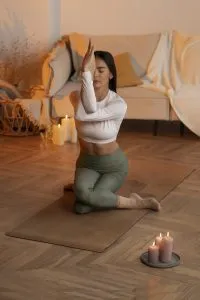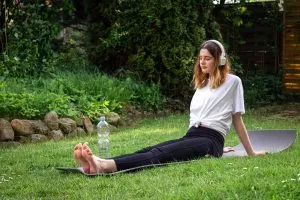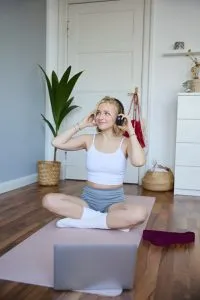You’re 25, springing out of bed like a jack-in-the-box, touching your toes without a single grunt, and feeling invincible. Fast forward a few decades, and suddenly getting up from your favorite chair requires a strategic plan and maybe a countdown. Sound familiar?
Here’s the thing about yoga and aging – it’s not about turning back the clock or pretending your knees are still 20. It’s about embracing where you are while giving your body the best possible support for the journey ahead. And trust me, after years of teaching yoga to students ranging from flexible teenagers to wisdom-filled 80-year-olds, I’ve learned that age really is just a number when you have the right tools.
The beauty of yoga lies in its gentle rebellion against the assumption that getting older means getting weaker, stiffer, or less capable. In fact, recent research from Harvard’s Brigham and Women’s Hospital shows that yoga can actually protect against frailty in older adults, improving walking speed and the ability to rise from a chair – two key predictors of longevity.
So, whether you’re in your 40s noticing those first creaky morning moments, your 60s dealing with balance concerns, or your 80s proving that age is just attitude, this guide will show you how yoga can be your loyal companion through every season of life.
The Science Behind Yoga for Seniors – More Than Just Stretching
When people think about yoga for seniors, they often picture gentle stretches and meditation. While those elements are crucial, the science reveals something far more exciting: yoga is like a Swiss Army knife for aging bodies.
Your Body’s Aging Story (And How Yoga Rewrites It)
As we age, our bodies tell a predictable story. Bone density decreases, muscles lose elasticity, balance becomes shakier, and that notorious stiffness creeps in. But here’s where yoga becomes the plot twist your body didn’t see coming.
A comprehensive review of 33 studies involving over 2,000 participants found that yoga significantly improves walking speed – and this isn’t just about getting to the mailbox faster. Walking speed is such a reliable predictor of longevity that doctors often call it the “sixth vital sign.”
The Cellular Level Magic
But yoga’s anti-aging powers go deeper than what meets the eye. Research shows that regular yoga practice can actually influence cellular aging, potentially slowing the deterioration that happens at the most fundamental level of our bodies. It’s like having a maintenance crew working the night shift, quietly repairing and strengthening while you sleep.
Flexibility Exercises for Older Adults – Beyond the Basic Stretch
Remember when “flexible” meant being able to put your leg behind your head? (If you ever could do that – no judgment if you couldn’t!) As we age, flexibility takes on a more practical meaning: reaching for items on high shelves without wincing, getting in and out of cars gracefully, or simply feeling comfortable in your own skin.
The Myth of “Too Late to Start”
I once had a student, Margaret, who started yoga at 73. She’d convinced herself she was “too stiff” for yoga, imagining rooms full of pretzel-people doing impossible poses. Six months later, she was leading her retirement community’s morning stretch sessions. Her secret? She focused on flexibility exercises for older adults that met her where she was, not where she thought she should be.
Smart Flexibility Strategies
The key to maintaining and improving flexibility as we age isn’t about forcing your body into Instagram-worthy poses. It’s about consistent, gentle movement that honors your body’s current capabilities while encouraging gradual improvement.
Gentle morning stretches can be your best friend. Think cat-cow stretches in bed before your feet hit the floor, or simple neck rolls while your coffee brews. These small moments of movement throughout the day often matter more than one intense yoga session per week.
Yin yoga deserves special mention here. With its longer holds and passive stretches, it specifically targets the connective tissue that tends to tighten as we age. It’s meditation in motion, giving your fascia the time it needs to release and lengthen.
Strength Training Through Yoga – Building Power Without the Gym
Who says you need heavy weights to build strength? Strength training through yoga might be one of the best-kept secrets in the fitness world, especially for aging bodies that need functional strength more than show-off muscles.
Your Body Weight is Your Best Equipment
Every time you move from sitting to standing in Chair Pose, you’re doing a squat. When you hold Warrior II, you’re building leg strength that translates directly to climbing stairs and getting up from low chairs. The brilliant thing about yoga is that it builds strength in the context of real-life movements.
Core Strength: Your Body’s Natural Corset
Here’s something most people don’t realize: core strength isn’t just about abs. It’s about creating stability for your entire body. As we age, a weak core often leads to back pain, poor posture, and increased fall risk.
Yoga poses like Plank, Modified Side Plank, and even gentle Boat Pose variations can build the deep core strength that acts like a natural corset, supporting your spine and improving your posture. And unlike crunches at the gym, these poses also improve balance and body awareness.
The Balance Connection
Speaking of balance – this might be yoga’s most underrated superpower for aging adults. Balance isn’t just about not falling (though that’s pretty important). It’s about confidence, independence, and the ability to navigate the world without fear.
Tree Pose might seem like a simple balance pose, but it’s actually training your proprioception – your body’s ability to sense where it is in space. This awareness diminishes as we age, but yoga can help maintain and even improve it.
Addressing Common Age-Related Health Concerns Through Yoga
Arthritis and Joint Pain: Moving Despite the Ache
If you’re dealing with arthritis, the last thing you might want to do is move. But gentle movement is often exactly what inflamed joints need. Recent research shows that regular yoga practice can reduce joint pain and improve flexibility for people with arthritis.
The key is modification. Chair yoga can be just as effective as mat-based practice. Wall-supported poses can provide the benefits of standing poses without the strain. Remember, yoga meets you where you are – not where you think you should be.
Osteoporosis and Bone Health: Building Strength From Within
For those concerned about bone density, weight-bearing yoga poses can be incredibly beneficial. Poses like Warrior I and II, where you’re supporting your body weight, can help maintain bone strength. However, if you have osteoporosis, certain poses (like deep forward folds or twists) might need modification or should be avoided entirely.
This is where working with a qualified instructor becomes invaluable. They can help you create a practice that supports your bones without putting them at risk.
Sleep and Stress: The Gentle Evening Practice
Aging often brings sleep challenges, but yoga offers some beautiful solutions. A gentle evening practice with restorative poses can signal to your nervous system that it’s time to wind down. Poses like Legs-Up-the-Wall or a supported Child’s Pose can activate your parasympathetic nervous system – your body’s natural relaxation response.
Creating Your Sustainable Yoga and Aging Practice
Start Where You Are, Not Where You Were
This might be the most important advice I can give: your yoga practice at 60 doesn’t need to look like it did at 30. And if you’re starting yoga for the first time in your later years, you don’t need to catch up to anyone else’s practice.
The Power of Props and Modifications
Props aren’t cheating – they’re tools for empowerment. Blocks can bring the floor closer to you. Straps can extend your reach. Chairs can provide stability. Bolsters can support restorative poses. These tools allow you to access the benefits of poses safely and comfortably.
Building Consistency Over Intensity
A 15-minute daily practice will serve you better than a 90-minute weekly class that leaves you sore and discouraged. Consistency is the secret ingredient that makes yoga such a powerful tool for healthy aging.
The Mental and Emotional Benefits: Yoga’s Hidden Treasures
While we’ve focused on the physical benefits, let’s not forget that yoga and aging encompasses so much more than flexibility and strength. Regular practice can improve mood, reduce anxiety, and provide a sense of community – especially important as social circles sometimes shrink with age.
The mindfulness aspect of yoga teaches us to be present in our bodies as they are, not as they were or as we wish they could be. This acceptance can be profoundly liberating, especially in a culture that often views aging as something to fight against rather than embrace.
FAQs: Your Most Common Questions About Yoga and Aging
Is it safe to start yoga in my 60s, 70s, or beyond?
Absolutely! In fact, many people find yoga more beneficial as they age because they approach it with patience and wisdom rather than ego. The key is starting slowly, working with qualified instructors, and communicating with your healthcare provider about any concerns. Chair yoga and gentle classes specifically designed for seniors are excellent starting points.
What if I’m not flexible at all? Can yoga still help me?
Flexibility is not a prerequisite for yoga – it’s a result of yoga. I’ve seen students who couldn’t touch their knees eventually reach their toes, not because reaching toes was the goal, but because consistent gentle movement gradually increased their range of motion. Remember, yoga is about progress, not perfection.
How often should older adults practice yoga?
Quality over quantity is the rule here. A short 15-20 minute daily practice is more beneficial than one long weekly session. Even 5-10 minutes of gentle movement daily can make a significant difference in how you feel. Listen to your body and build gradually – your future self will thank you.
Can yoga help with balance problems and fall prevention?
Yes! Balance is one of yoga’s greatest gifts to aging adults. Poses like Tree Pose, Warrior III, and even simple standing poses help improve proprioception and strengthen the small stabilizing muscles that keep us upright. Studies show that regular yoga practice can significantly reduce fall risk in older adults.
What style of yoga is best for seniors?
Gentle Hatha yoga, Chair yoga, Yin yoga, and Restorative yoga are excellent choices for older adults. These styles emphasize longer holds, proper alignment, and accessibility. Avoid heated classes or vigorous flows unless you’re already an experienced practitioner. The best style is the one you’ll actually practice consistently.
Your Next Step: Embracing Yoga and Aging with Confidence
The journey of yoga and aging isn’t about defying time – it’s about partnering with it. Every day you choose to move your body mindfully, you’re investing in your future self. You’re choosing strength over stiffness, balance over fear, and presence over regret.
Whether you’re just beginning to explore yoga or looking to adapt your existing practice for changing needs, remember that the most important pose is the next one you take. Your body has carried you this far – yoga is simply a way to support it for all the adventures still to come.
Ready to start or deepen your practice? Consider joining a gentle yoga class in your community, exploring online resources designed for older adults, or working with a yoga instructor who understands the unique needs of aging bodies. Your future self – more flexible, stronger, and more balanced – is waiting for you on the mat.
Remember to consult with your healthcare provider before beginning any new exercise routine, especially if you have existing health conditions or concerns.















